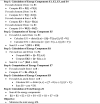A robust optimization model for multi-objective blood supply chain network considering scenario analysis under uncertainty: a multi-objective approach
- PMID: 38658546
- PMCID: PMC11043422
- DOI: 10.1038/s41598-024-57521-0
A robust optimization model for multi-objective blood supply chain network considering scenario analysis under uncertainty: a multi-objective approach
Abstract
Annually, different regions of the world are affected by natural disasters such as floods and earthquakes, resulting in significant loss of lives and financial resources. These events necessitate rescue operations, including the provision and distribution of relief items like food and clothing. One of the most critical challenges in such crises is meeting the blood requirement, as an efficient and reliable blood supply chain is indispensable. The perishable nature of blood precludes the establishment of a reserve stock, making it essential to minimize shortages through effective approaches and designs. In this study, we develop a mathematical programming model to optimize supply chains in post-crisis scenarios using multiple objectives. Presented model allocates blood to various demand facilities based on their quantity and location, considering potential situations. We employ real data from a case study in Iran and a robust optimization approach to address the issue. The study identifies blood donation centers and medical facilities, as well as the number and locations of new facilities needed. We also conduct scenario analysis to enhance the realism of presented approach. Presented research demonstrates that with proper management, crises of this nature can be handled with minimal expense and deficiency.
Keywords: Blood supply chain; Disaster; HealthCare; Robustness.
© 2024. The Author(s).
Conflict of interest statement
The authors declare no competing interests.
Figures










Similar articles
-
Multi-objective location-distribution optimization in blood supply chain: an application in Turkiye.BMC Public Health. 2024 Nov 15;24(1):3181. doi: 10.1186/s12889-024-20647-x. BMC Public Health. 2024. PMID: 39543531 Free PMC article.
-
A Location-Allocation-Vehicle Routing Model for Humanitarian Blood Supply Chain in Aftermath of Earthquake under IER Uncertainty Considering Quality Concepts.Disaster Med Public Health Prep. 2025 May 21;19:e122. doi: 10.1017/dmp.2025.19. Disaster Med Public Health Prep. 2025. PMID: 40394755
-
An integrated blockchain-enabled multi-channel vaccine supply chain network under hybrid uncertainties.Sci Rep. 2024 Oct 1;14(1):22829. doi: 10.1038/s41598-024-67071-0. Sci Rep. 2024. PMID: 39353990 Free PMC article.
-
A fuzzy interval dynamic optimization model for surface and groundwater resources allocation under water shortage conditions, the case of West Azerbaijan Province, Iran.Environ Sci Pollut Res Int. 2024 Apr;31(17):26217-26230. doi: 10.1007/s11356-024-32919-5. Epub 2024 Mar 18. Environ Sci Pollut Res Int. 2024. PMID: 38494570 Review.
-
Management of blood shortages in a tertiary care academic medical center: the Yale-New Haven Hospital frozen blood reserve.Transfusion. 2008 Oct;48(10):2252-63. doi: 10.1111/j.1537-2995.2008.01816.x. Epub 2008 Jul 8. Transfusion. 2008. PMID: 18631164 Review.
Cited by
-
Multi-objective location-distribution optimization in blood supply chain: an application in Turkiye.BMC Public Health. 2024 Nov 15;24(1):3181. doi: 10.1186/s12889-024-20647-x. BMC Public Health. 2024. PMID: 39543531 Free PMC article.
-
A robust optimization model for allocation-routing problems under uncertain conditions.PLoS One. 2025 May 16;20(5):e0322483. doi: 10.1371/journal.pone.0322483. eCollection 2025. PLoS One. 2025. PMID: 40378102 Free PMC article.
References
-
- Jabbarzadeh A, Fahimnia B, Seuring S. Dynamic supply chain network design for the supply of blood in disasters: A robust model with real world application. Transp. Res. Part E: Logist. Transp. Rev. 2014;70:225–244. doi: 10.1016/j.tre.2014.06.003. - DOI
-
- Sha Y, Huang J. The multi-period location-allocation problem of engineering emergency blood supply systems. Syst. Eng. Procedia. 2012;5:21–28. doi: 10.1016/j.sepro.2012.04.004. - DOI
-
- Sasser, S. M. et al. In a moment's notice; surge capacity for terrorist bombings: Challenges and proposed solutions (2007).
Publication types
MeSH terms
LinkOut - more resources
Full Text Sources

